Red-tails are pairing up all over the place.
The numerous island mountain ranges within western Utah’s Basin and Range country provide ideal nesting habitat for many raptor species and two days ago I saw ample evidence of that fact when I spent some time out there. Raptor numbers are noticeably increasing and Red-tailed Hawks in particular have paired up and are beginning nesting activities. I had good looks at four pairs of red-tails that were obviously bonded and at least some of them were building or refurbishing nests.
This is one of them.
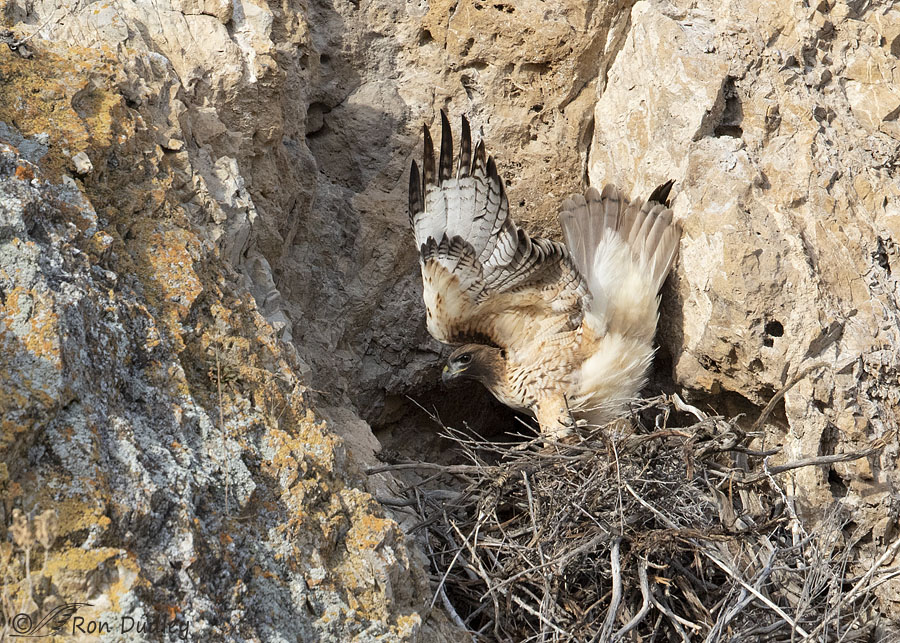
1/1600, f/6.3, ISO 500, Canon 7D Mark II, Canon EF 500mm f/4L IS II USM + EF 1.4 III Extender, not baited, set up or called in
This shot was taken just after one of the hawks landed on the nest and before it had time to fold its wings and lower its tail. At this point they nearly always had their backs to me but this time I got a fairly good look at the head with the hawk in an interesting posture. With the head in shade I was pleasantly surprised to get light in the eye.
I haven’t spent enough time with these hawks to confidently know which one is the male and which one is the female so I’ll refer to them generically. The bird in most of these photos is missing a primary feather on its right wing but I’m not sure if it’s the male or the female.
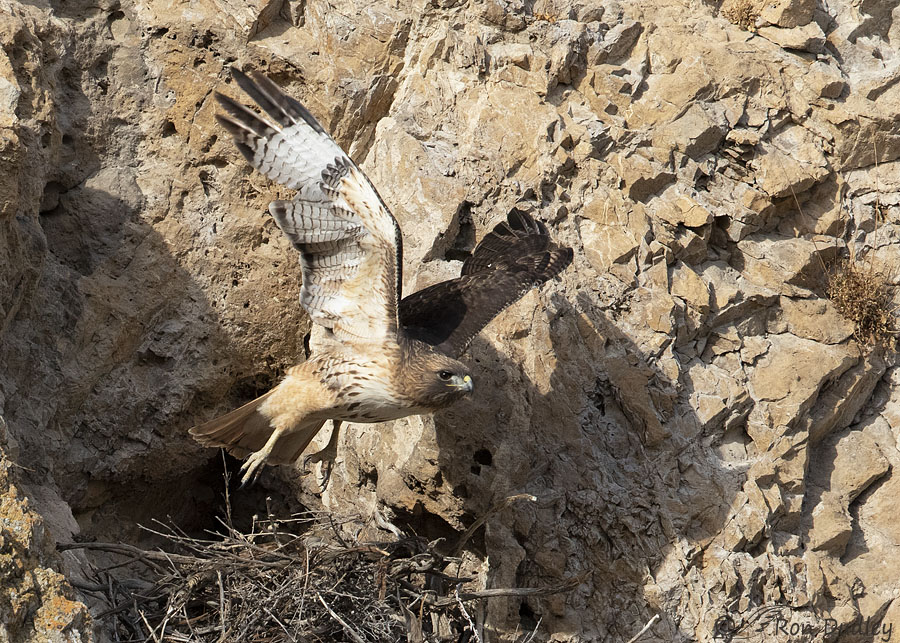
1/3200, f/6.3, ISO 800, Canon 7D Mark II, Canon EF 500mm f/4L IS II USM + EF 1.4 III Extender, not baited, set up or called in
This is the same hawk taking off from the nest.
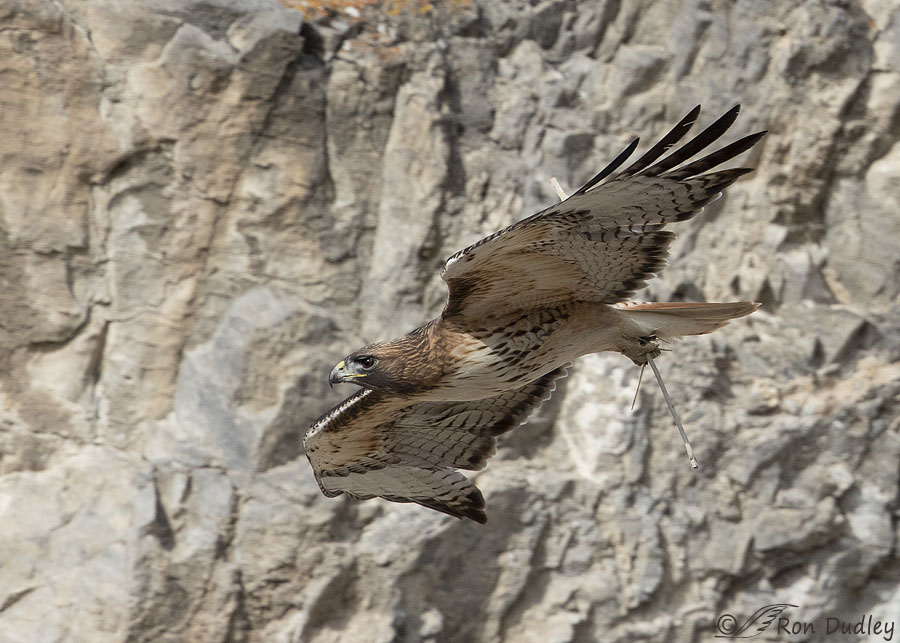
1/2500, f/7.1, ISO 800, Canon 7D Mark II, Canon EF 500mm f/4L IS II USM + EF 1.4 III Extender, not baited, set up or called in
I had several opportunities to photograph them bringing nesting material to the nest but they always had their backs to me or they were so close to the cliff I found it very difficult to get my active focus point locked onto the bird instead of the rocks in the background.
This hawk was carrying the nesting material in its talons instead of its beak. The stick is longer than it first appears to be – notice that one end of it can be seen sticking up behind the middle of the left wing.
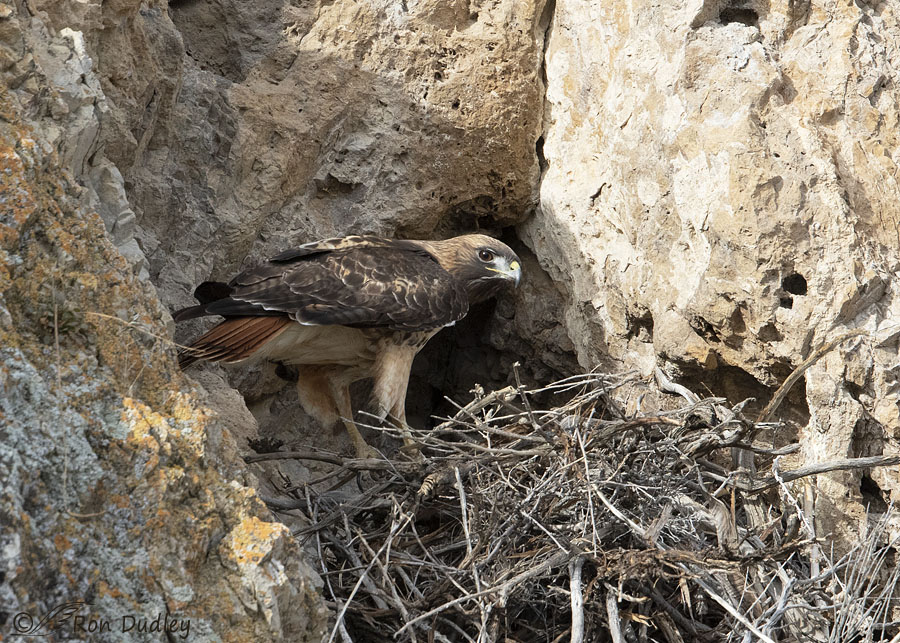
1/1600, f/7.1, ISO 800, Canon 7D Mark II, Canon EF 500mm f/4L IS II USM + EF 1.4 III Extender, not baited, set up or called in
The same bird after it had incorporated the stick into the nest.
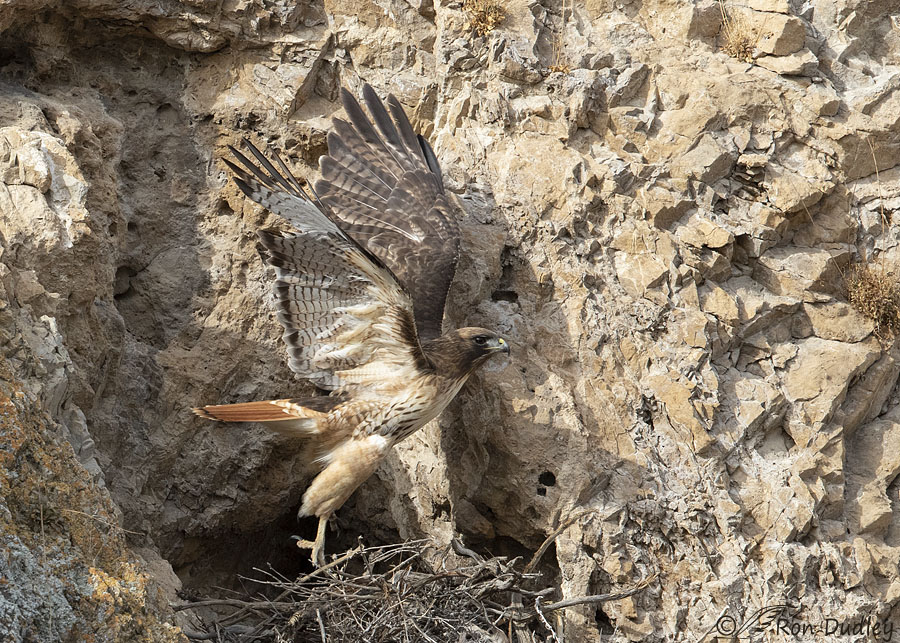
1/1600, f/7.1, ISO 800, Canon 7D Mark II, Canon EF 500mm f/4L IS II USM + EF 1.4 III Extender, not baited, set up or called in
It was tricky to get decent takeoff shots from the nest, in part because the light there was so contrasty with lots of shadows and brightly lit rocks.
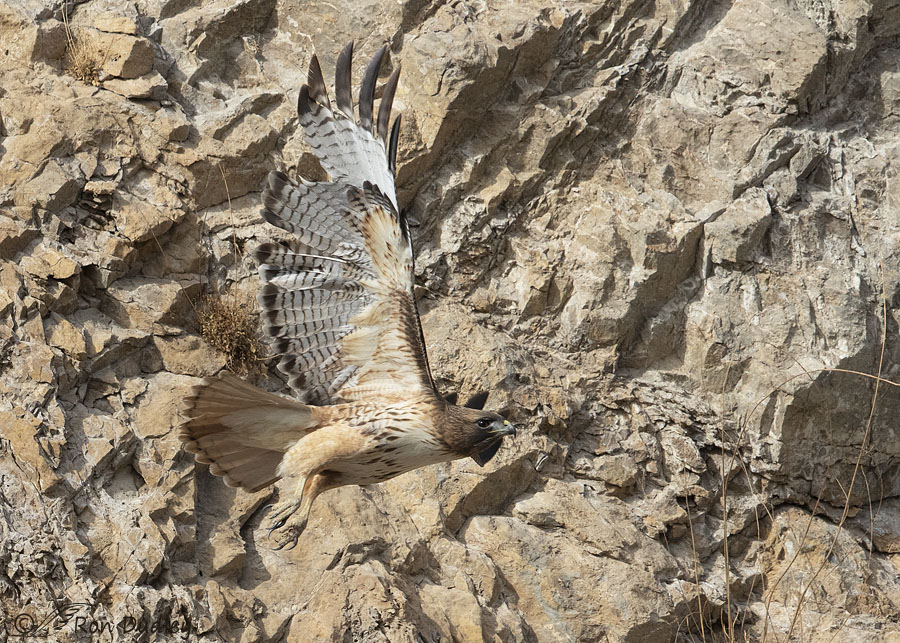
1/2500, f/7.1, ISO 800, Canon 7D Mark II, Canon EF 500mm f/4L IS II USM + EF 1.4 III Extender, not baited, set up or called in
These typically colored western red-tails were so incredibly cryptic against the rocks of similar colors they almost disappeared when they had the cliff face in the background. I struggled to spot them in flight almost as much as my camera struggled to keep focus points locked onto them. I consider this photo a success even though the hawk blends into the background.
It’s a very long drive for me to get to remote locations like this but I still hope to make enough trips so that I can follow these hawks and others through the nesting season.
I’d love to photograph their recently fledged youngsters learning the ropes.
Ron
Notes:
- Rest assured, I didn’t get close to these hawks or disturb them. I was shooting at an effective 1120mm and these photos have been significantly cropped. I never once got out of my pickup but even so, if I’d noticed any significant change in their behavior as a result of my presence I’d have left the area immediately.
- I don’t reveal nest locations. Please don’t ask.


Great series Ron My favorite time… nest building & bonding
My favorite time… nest building & bonding  Fun to know that you will have a nest to watch. For me it’s a given that your a respectful wildlife photographer… That’s why I follow you
Fun to know that you will have a nest to watch. For me it’s a given that your a respectful wildlife photographer… That’s why I follow you 
I appreciate your confidence in me, Diana.
Ohboyohboyohboy! So excited to see these Red Tails making nestorations! Can’t wait to see some bobbleheads.
Bonus points to the man behind the lens for taking such spectacular shots in such a high degree of difficulty situation! And for taking the ethical high road. Always.
Thanks x 3, Marty. I’m excited too. Now if it only happens.
Sensational series Ron, thanks for sharing!
Charlotte Norton
Thanks, Charlotte.
Very exciting, Ron. We’ve seen lots of hawks/other raptors on our trips to Pullman, WA the last week – nests, sitting birds, soaring birds (many pairs). And with each one I was thinking “I need Ron’s closeups!” Thank you for what you do!
Carolyn Miller
Carolyn, “Lots of hawks” is a good thing. I’m glad to hear it.
What a bunch of amazing photos. People see Red-tailed Hawks all the time, but how many have seen them nesting? I’m guessing one out of a bazillion.
I can certainly see how getting a focus lock on these RTH’s would be a challenge. One could think that they evolved their colors to match the rocks. Much more complicated, I’m sure….
Thanks, Lyle. Yes, it’s more complicated in red-tails than in most raptors because they have so much variation in patterns and colors.
Wonderful series. I really like seeing some of their habitat too. It looks unforgiving and spectacular – much like the birds.
Yup, it’s pretty harsh out there but it seems to fit their requirements. Thanks, EC.
I hope they have a successful year, we all look forward to your future posts!
Look at all the new feathers growing in on the wing in photo 6. You know I always look at condition as much as composition.
“You know I always look at condition as much as composition”
That’s the rehabber in you, April. I do the same thing but from a less knowledgeable perspective.
Beautiful images, Ron, and every one is particularly special because of the story they’re telling — “baby season” is coming! I’m so pleased to hear you’ve found lots of red-tail activity, and I’m hopeful that — your back willing — you will be able to make the trek out to this area to create more of your wonderful series that show the adorable young’uns growing and learning to be hawks!
Thanks, Chris. Yes, a cooperative back would definitely be helpful.
What a wonderful series! And thank you for making the long drive. Here’s hoping we can all get a glimpse of these Red-tails incubating and raising some fledglings.
I hope so, Cathy. For them and for us.
I am amazed you can even spot them from the distance you are from them. There is so much most of us miss that happens right around us and you share sights most of us will never have the opportunity to see. Thanks so much for what you do. Pictures are spectacular.
Much appreciated, Betty. I probably miss a lot too.
What cool photos, Ron. Thanks. And what a great nesting spot — you could almost call it “cozy,” if only it weren’t sticks ‘n’ stones. Lovely!
Lovely!
I’m sure it’s cozy for them, Ellen. And at least somewhat protected from that cold north wind.
Beautiful! The certainly DO blend into the rocks and locking in the auto focus WOULD be a challenge. Amazing to me how they can navigate such tight quarters.
The certainly DO blend into the rocks and locking in the auto focus WOULD be a challenge. Amazing to me how they can navigate such tight quarters. Hope you can return and watch/capture the young learning what life is all about…..they ARE fun to watch.
Hope you can return and watch/capture the young learning what life is all about…..they ARE fun to watch.
Canada Geese have paired off here and the Rosy Finches have done their usual “poof” they’re gone thing. A couple of Robins are back so spring IS on the way….
Thanks, Judy. I’ve told you before I envy you all your rosy finches.
Love red tails! Can’t wait for the baby photos!!
I hope they happen, Kathleen.
A tremendous series Ron. I agree with Everett about the photography / education combination. A staple of your blog I really enjoy and look forward to each morning.
I hope you are able to return to that area often to share the young’s growth and antics with us. Thanks as always.
Thank you, Mark. It takes a lot of driving to get out there and you never know what you’ll find and won’t find when you arrive but I intend to give it my best shot.
Another series that combines outstanding photography with education. Really special to see them building their nests. Couple years back I watched eagles doing the same, but too far for decent photos. From a distance many could miss their presence there with the way their colors blend in with the rocks. I don’t think any of your regular followers would think you were getting close enough to disturb them, but good that you did include that explanation.
I did see a couple Red-tails perched very close to a nest yesterday, but no action to observe.
Everett, keep your eye on those red-tails if you can. This time of year when the two bonded birds are hanging out together is the best opportunity we have to photograph them while they’re mating. I was watching for it two days ago but it didn’t happen while I was there.
Great series. I particularly liked the look of the hawk after placing the stick.
Thank you, Arwen.